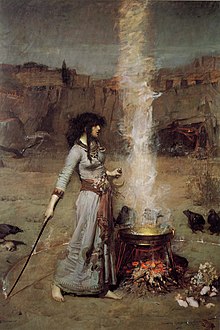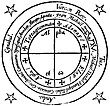
Back Heksery Afrikaans شعوذة Arabic السحر (ويتشكرافت) ARZ ডাইনীবিদ্যা Assamese Bruxería AST Cadugərlik Azerbaijani ডাকিনীবিদ্যা Bengali/Bangla Sorserezh Breton Bruixeria Catalan Čarodějnictví Czech

| Part of a series on |
| Witchcraft |
|---|
 |
| Part of a series on |
| Magic |
|---|
 |
Witchcraft is the use of alleged supernatural powers of magic. A witch is a practitioner of witchcraft. Traditionally, "witchcraft" means the use of magic or supernatural powers to inflict harm or misfortune on others, and this remains the most common and widespread meaning.[1] According to Encyclopedia Britannica, "Witchcraft thus defined exists more in the imagination", but it "has constituted for many cultures a viable explanation of evil in the world".[2] The belief in witchcraft has been found throughout history in a great number of societies worldwide. Most of these societies have used protective magic or counter-magic against witchcraft, and have shunned, banished, imprisoned, physically punished or killed alleged witches. Anthropologists use the term "witchcraft" for similar beliefs about harmful occult practices in different cultures, and these societies often use the term when speaking in English.[3][4][5]
Belief in witchcraft as malevolent magic is attested from ancient Mesopotamia, and in Europe, belief in witches traces back to classical antiquity. In medieval and early modern Europe, accused witches were usually women[6] who were believed to have secretly used black magic (maleficium) against their own community. Usually, accusations of witchcraft were made by neighbors of accused witches, and followed from social tensions. Witches were sometimes said to have communed with demons or with the Devil, though anthropologist Jean La Fontaine notes that such accusations were mainly made against perceived "enemies of the Church".[7] It was thought witchcraft could be thwarted by white magic, provided by 'cunning folk' or 'wise people'. Suspected witches were often prosecuted and punished, if found guilty or simply believed to be guilty. European witch-hunts and witch trials in the early modern period led to tens of thousands of executions. While magical healers and midwives were sometimes accused of witchcraft themselves,[8][4][9][10] they made up a minority of those accused. European belief in witchcraft gradually dwindled during and after the Age of Enlightenment.
Many indigenous belief systems that include the concept of witchcraft likewise define witches as malevolent, and seek healers (such as medicine people and witch doctors) to ward-off and undo bewitchment.[11][12] Some African and Melanesian peoples believe witches are driven by an evil spirit or substance inside them. Modern witch-hunting takes place in parts of Africa and Asia.
Today, followers of certain types of modern paganism identify as witches and use the term "witchcraft" or "pagan witchcraft" for their beliefs and practices.[13][14][15] Other neo-pagans avoid the term due to its negative connotations.[16]
- ^ Hutton (2017), p. ix; Thomas (1997), p. 519.
- ^ Russell, Jeffrey Burton; Lewis, Ioan M. (2023). "Witchcraft". Encyclopedia Britannica. Archived from the original on 28 June 2023. Retrieved 28 July 2023.
Although defined differently in disparate historical and cultural contexts, witchcraft has often been seen, especially in the West, as the work of crones who meet secretly at night, indulge in cannibalism and orgiastic rites with the Devil, or Satan, and perform black magic. Witchcraft thus defined exists more in the imagination of contemporaries than in any objective reality. Yet this stereotype has a long history and has constituted for many cultures a viable explanation of evil in the world.
- ^ Singh, Manvir (2 February 2021). "Magic, Explanations, and Evil: The Origins and Design of Witches and Sorcerers". Current Anthropology. 62 (1): 2–29. doi:10.1086/713111. ISSN 0011-3204. S2CID 232214522. Archived from the original on 18 July 2021. Retrieved 28 April 2021.
- ^ a b Thomas (1997), p. 519.
- ^ Perrone, Bobette; Stockel, H. Henrietta; Krueger, Victoria (1993). Medicine women, curanderas, and women doctors. University of Oklahoma Press. p. 189. ISBN 978-0806125121. Archived from the original on 23 April 2017. Retrieved 8 October 2010.
- ^ "Witchcraft accusations were an 'occupational hazard' for female workers in early modern England". 19 September 2023.
- ^ La Fontaine, J. (2016). Witches and Demons: A Comparative Perspective on Witchcraft and Satanism. Berghahn Books. pp. 33–34. ISBN 978-1785330865.
- ^ Davies (2003), pp. 7–13.
- ^ Riddle, John M. (1997). Eve's Herbs: A History of Contraception and Abortion in the West. Cambridge, Mass.: Harvard University Press. pp. 110–119. ISBN 0674270266.
- ^ Ehrenreich & English (2010), pp. 31–59.
- ^ Demetrio, F. R. (1988). Philippine Studies Vol. 36, No. 3: Shamans, Witches and Philippine Society, pp. 372–380. Ateneo de Manila University.
- ^ Tan, Michael L. (2008). Revisiting Usog, Pasma, Kulam. University of the Philippines Press. ISBN 978-9715425704. Archived from the original on 26 January 2021. Retrieved 17 September 2020.
- ^ Doyle White, Ethan (2016). Wicca: History, Belief, and Community in Modern Pagan Witchcraft. Liverpool University Press. pp. 1–9, 73. ISBN 978-1-84519-754-4.
- ^ Berger, Helen A.; Ezzy, Douglas (September 2009). "Mass Media and Religious Identity: A Case Study of Young Witches". Journal for the Scientific Study of Religion. 48 (3): 501–514. doi:10.1111/j.1468-5906.2009.01462.x. ISSN 0021-8294. JSTOR 40405642.
- ^ Kelly, Aidan A. (1992). "An Update on Neopagan Witchcraft in America". In James R. Lewis; J. Gordon Melton (eds.). Perspectives on the New Age. Albany: State University of New York Press. pp. 136–151. ISBN 978-0791412138.
- ^ Lewis, James (1996). Magical Religion and Modern Witchcraft. SUNY Press. p. 376.